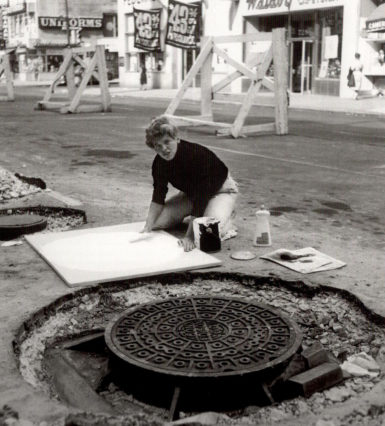[ad_1]

Gillian Jagger in New York, 1964.
COURTESY OF DAVID LEWIS GALLERY
Gillian Jagger, a sculptor acclaimed for her unflinching interrogations of the natural world, died on October 21, the New York Times reported. She was 88. Her death was confirmed by her wife Connie Mander. The cause of death was not specified, though Mander said Jagger had had difficulty breathing at their longtime home in upstate New York and was taken to the hospital, where she died.
Jagger eschewed the limelight of New York City for upstate in the late ’70s, soon after garnering attention for her towering plaster castings which incorporated the natural and unnatural: a dead cat, tree trunks, and, famously, manhole covers. Her 1999 sculpture, the airborne Rift, was comprised of bones and carcasses of animals.
Jagger was uninterested in irony or designations like Land Art and Post-Minimalism that were often attached to her creations. “What is it that matters?” she asked in a 2016 interview with the Brooklyn Rail, while discussing her work. “How can I get out of myself, and what is there out there that can integrate what is true—emotionally, spiritually, intellectually, physically?”
Gillian Gwendolyn Jagger was born in London in 1930 to a family of artists. Her father, Charles Sargeant Jagger, was a British realist sculptor. Concerns of death—a lifelong preoccupation—arrived with the childhood passing of her sister. Art “became how I knew I was a whole human being,” she said in the documentary, Following Gillian.
She received a bachelor of fine arts degree in 1953 from Carnegie Tech (now Carnegie Mellon University) in Pittsburgh, where she studied with the painter Balcomb Greene. After graduation she followed fellow Carnegie Tech graduate, Andy Warhol, to New York City. He helped get her into her first show, a group exhibition at Loft Gallery in Midtown Manhattan in 1956. She received her master’s from New York University in 1960; soon followed her first solo show of paintings at Ruth White Gallery. Jagger taught at Pratt Institute in Brooklyn for nearly 40 years, becoming a professor emeritus in 2009. She began showing with Phyllis Kind in 1998, before being represented by David Lewis.
“Her work is attuned to and profoundly sensitive of the natural world as it is, anticipating later important theoretical insights into problems of speciesism, the environment, and questions of life and survival,” the gallery wrote in a statement.
[ad_2]
Source link

